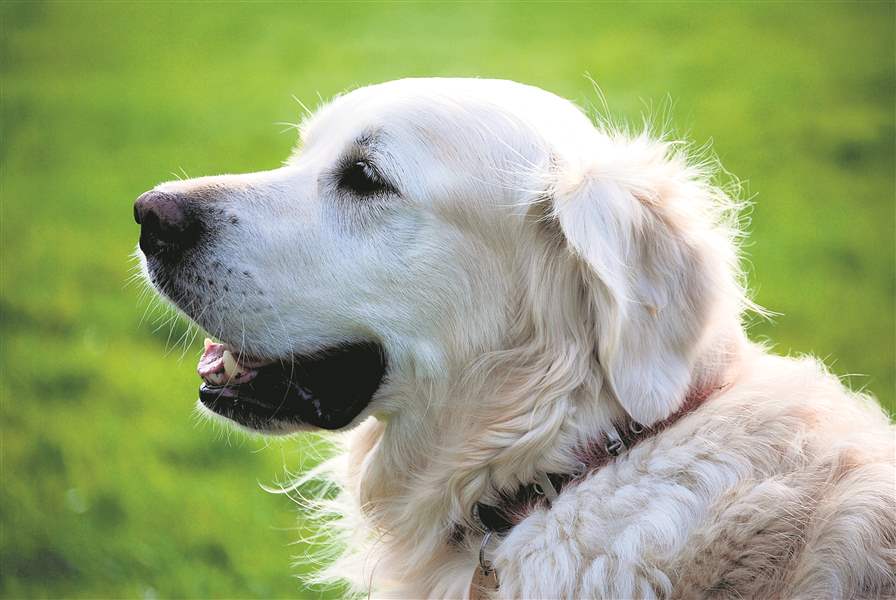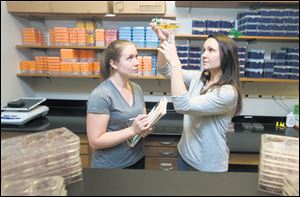
BGSU researcher is taking a closer look at dog DNA
11/26/2017
Researchers are trying to determine why the effects of retroviruses are rarer in the canine genome than in humans.
Julia Wildschutte, an assistant professor of biological sciences at Bowling Green State University, is taking a new look at the canine genome, and her research is beginning to reveal that some long-held held beliefs about what it contains may not be entirely accurate.
A specialist in virus-host interactions, professor Wildschutte has a $300,000, three-year Academic Research Enhancement Award from the National Institutes of Health to study the properties and impact of endogenous retroviral elements to the canine.

Researchers are trying to determine why the effects of retroviruses are rarer in the canine genome than in humans.
“When a retrovirus infects a cell, it integrates a DNA ‘copy’ of its genome, or ‘provirus,’ into the nuclear genome of that cell,” she explained. “This means that if a retrovirus is able to infect a germ cell, the provirus may inadvertently be passed on to offspring. And this unlikely scenario has happened a lot in mammalian evolution. Fully 8 percent of the human genome is derived from retroviruses.
“In mice, it’s about the same. But dogs are interesting,” she said. “In dogs, it’s only 0.15 percent. How did it happen that dogs have missed such a rich history of retroviruses infecting their germ line?”
Professor Wildschutte became interested in these elements, termed “endogenous retroviruses,” during her doctoral work at Tufts University and continued in the field as a post-doctoral fellow at the University of Michigan. There, she was part of a three-university team examining a type of endogenous retrovirus in human genomes known as HERV-K, which is thought to have possible roles in certain diseases.
In evolutionary terms, HERV-K is relatively young, having infected our ancestors in the last 150,000 to 200,000 years. The team found a completely intact provirus, along with numerous other bits of ancient retroviruses, within human DNA genomes. Wildschutte was first co-author on a paper the team published in the Proceedings of the National Academy of Sciences about their discoveries and characterizations of HERV-K.
“These retroviral remnants are evolving as part of us,” professor Wildschutte said. “Some of the integrations are amazing,” including ethnic diversity.
She has expanded her interest in host-virus interaction and retroviruses to a different model system — the canine — and has applied the sophisticated techniques and analysis that her former team performed on human virus genomes to species in the canidae line, which includes wolves, jackals, coyotes and other related groups.
“How could this be?” professor Wildschutte said. “Dogs don’t have any retroviruses that we know of. We humans have circulating retroviruses: We have HIV, we have HTLV, which causes leukemia.
“Species that dogs prey on, like mice, have circulating retroviruses. Mice have a leukemia virus and one that causes mammary tumors or breast cancer; cats have FELV and FIV; birds have ALV, but we don’t see any currently circulating retroviruses in dogs.
“This raises the possibility that canines, and their ancestors, are somehow able to evade such retroviruses, and we don’t know why. Not a lot of research has gone into that yet. That’s something that is really interesting to me.”

Julia Wildschutte, right, and graduate assistant Abigail Jarosz study canine DNA and its relationship to retroviruses at Bowling Green State University.
Evidence that retroviruses existed in canine ancestors can be inferred by examining the genomes of contemporary canids for the presence of endogenous retroviruses. She and her team searched through roughly 350 canid genomes, including DNA from breed dogs (pets), “village dogs” (scavengers), wolves, coyotes, jackals, and other outgroups.
They found an unexpectedly high amount of genetic variability and insertions of endogenous retroviruses in those samples. In addition, “these insertions were obviously from an evolutionarily recent circulating virus, within the last several hundred thousand years,” she said. “It was a very similar analysis to our HERV-K that previously infected human genomes.”
She is preparing to publish the findings from this first round of discovery.
“This was something in the field that was unexpected, and people really didn’t expect to find this high variability of these endogenous retroviral insertions in dog genomes,” professor Wildschutte said. “Plus, they had the signature of being fairly new. It’s sort of like a new lineage, and it is seems to be specific to the canidae lineage.”
But if the retroviruses are there in the genes, why are they not circulating in the dogs? And why are they not having an effect?
Based on her recent findings, it’s possible they are, professor Wildschutte said. Though never explored, there have been inklings over the years of possible endogenous retroviruses in dogs.
“There were a few reports, maybe 15 or 20 in all, of observations of retrovirus-like particles (not infectious) in some dog tumors and in tissues from dogs that had lymphoma or leukemia,” she said.
“I think it’s possible that the expression people observed in those dogs and other signatures of a retrovirus having been present are from this group of endogenous retroviruses we’ve just characterized.”
In humans, this HERV-K has provoked a response in several different types of cancers and diseases. It’s not entirely clear what consequence this has, professor Wildschutte said, but this is an active area of research.
“The regulation of the endogenous retroviruses in diseased tissues is very different that you would observed in otherwise normal cells,” Wildschutte said. “So a question is: Are the retroviral proteins contributing to that state, or is the expression just a consequence, or even if it is, does it still have an impact?”
“This dog group is very new, and while I wasn’t expecting to find so much variability of insertions in dogs, it’s there. What I’m interested in now is to investigate the prevalence and patterns of these elements and their expression in canine tissues.”
Julia Wildschutte, Ph.D., is a Bowling Green State University assistant professor in biological sciences. For more information, go to bgsu.edu.